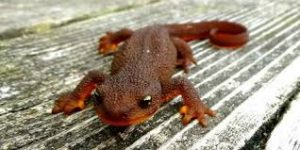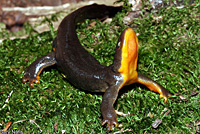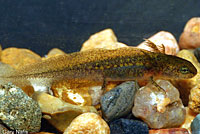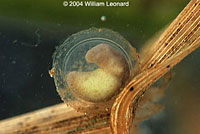There’s a New Newt in Town
 Project Watershed’s larger than life sized newt mascot debuted at the Royston School Keeping It Living Award Ceremony on Friday the 18th (Scroll down to enter the name our newt contest!). Royston School received the award for their contribution to salt marsh planting near the Royston Wrecks. The ceremony was held in the auditorium for the grade 1’s and 2’s. The newt got a warm welcome and everyone was excited to shake its hand and give it high fives.
Project Watershed’s larger than life sized newt mascot debuted at the Royston School Keeping It Living Award Ceremony on Friday the 18th (Scroll down to enter the name our newt contest!). Royston School received the award for their contribution to salt marsh planting near the Royston Wrecks. The ceremony was held in the auditorium for the grade 1’s and 2’s. The newt got a warm welcome and everyone was excited to shake its hand and give it high fives. 
Project Watershed’s newt logo was inspired by the rough skinned newt, a common riparian zone inhabitant needing both terrestrial and aquatic habitats to survive. The very habitats that Project Watershed strives to protect.
The newt was created by volunteer Coral Dunn and will be making appearances at Project Watershed events in the future. For a donation to Project Watershed the newt will also show up at a birthday party or children’s event.
Unfortunately, the newt has no name. So we are inviting children of all ages to put their thinking caps on and name our newt!
The child with the chosen newt name will win a newt visit to their classroom or other children’s event and a stuffed newt toy as a memento.
-
- Newts have the ability to regenerate limbs, eyes, spinal cords, hearts, intestines, and upper and lower j
 aws!
aws! - Newts are carnivores (meat-eater). Their diet is based on various types of insects, eggs and larvae of other salamanders and (rarely) small fish.
- Some newts are mostly active during the night.
- Newts hibernate in winter usually under logs and stones and in rubble piles. Some individuals occasionally spend the winter in the bottom of ponds
- Many newts produce toxins in their skin secretions as a defense mechanism against predators. The rough-skinned newt secretes tetrodotoxin from the glands in the skin. This toxin belongs to the group of neurotoxins and it can induce skin irritation (after contact with skin) or paralysis and death (after oral intake) of humans. One newt contains enough toxin to kill 25.000 mice.
- The common garter snake is one of the rare animals that can safely consume rough-skinned newts.
- The rough-skinned newt exposes its brightly-colored belly in the case of danger by holding its tail curled up
 over its body as a warning to predators. Most predators retreat at this point because bright colored creatures are often toxic.
over its body as a warning to predators. Most predators retreat at this point because bright colored creatures are often toxic. - The rough-skinned newt can reach 5 to 8.5 inches in length.
- The rough-skinned newt spends most of its life on the solid ground. It lives in the water only during the breeding season.
- The mating season of rough-skinned newts takes place from December to July.
- Most newts breed in the water.
- Female newts lay one egg at a time on a specially selected piece of pond plant a few inches under the water. She sniffs the leave to make sure it has the right cellulose amount and then after laying one egg closes the leaf around it with her back legs and glues it shut over the egg and goes on to lay the next egg.
- Larvae live in the water until they complete transformation (process called metamorphosis) into juvenile newts. Metamorphosis lasts 4 to 5 months.

- Rough-skinned newt can survive 18 years in the wild and 19 years in the captivity.
- Newts have the ability to regenerate limbs, eyes, spinal cords, hearts, intestines, and upper and lower j
Sources:
http://www.onekind.org/education/animals_a_z/newt/,
http://www.californiaherps.com/salamanders/pages/t.granulosa.html


